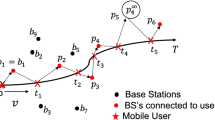Abstract
In third generation mobile telecommunication systems, signalling requirements due to location updating and paging are expected to be remarkable, mainly because of the huge number of mobile subscribers. Location area planning is characterised by the trade-off between the number of location updates and the amount of paging signalling that the network has to deal with. Location area planning should be based on criteria which guarantee that signalling load will be kept under tolerable levels. Various approaches for location area planning in a city environment—the worst case environment—are discussed in this paper. The simplest approach is the use of heuristic algorithms for approximating the optimum location area configuration. Then more complex scenarios which are based on geographical criteria (population distribution, highway topology, etc.) are investigated. Finally, user mobility characteristics are taken into account in the most complex scenarios. All scenarios are applied over a simulation model representing a city area, providing us with a very clear view of their performance characteristics.
Similar content being viewed by others
References
M. Mouly and M.B. Pautet,The GSM System for Mobile Communications (1992).
J. Sundborg, Universal personal telecommunication (UPT) concept and standardisation, Ericsson Review 4 (1993) 140–155.
RACE 2066 Mobile Networks (MoNet) project, CEC Deliverable No: R2066/BT/PM2/DS/070/b1, UMTS system structure document, Issue 1.0 (1994).
E.D. Sykas and M.E. Theologou, Numbering and addressing in IBCN for mobile communications, Proc. IEEE 79 (1991) 230–241.
A. Bar-Noy and I. Kessler, Tracking mobile users in wireless communications networks, IEEE Trans. Info. Theory 39 (1993) 1877–1886.
H. Xie, S. Tabbane and D.J. Goodman, Dynamic location area management and performance analysis,Proc. IEEE Veh. Tech. Conf., Secaucus, NJ (1993) 536–539.
S. Mohan and R. Jain, Two user location strategies for personal communication services, IEEE Personal Commun. Mag. 1 (1994) 42–50.
K.S. Meier-Hellstern and E. Alonso, The use of SS7 and GSM to support high density personal communications,Proc. IEEE ICC'92, Chicago, IL (1992) 1689–1702.
G. Brody, J. Parker and J. Wasserman, Subscriber tracking and locating in personal communications networks,Proc. Int. Switching Symp., Yokohama, Japan (1992) 307–311.
G.P. Pollini and S. Tabbane, The intelligent network signaling and switching costs of an alternate location strategy using memory,Proc. IEEE Veh. Tech. Conf., Secaucus, NJ (1993) 931–934.
C.N. Lo, S. Mohan and R.S. Wolf, An estimate of network database transaction volume to support voice and data personal communications services,Proc. 8th ITC Specialist Seminar on Personal Telecommunication, Genova, Italy (1992) 293–311.
C.N. Lo, R.S. Wolf and R.C. Bernhardt, An estimate of network database transaction volume to support personal communication services,Proc. 1st Int. Conf. on Universal Personal Commun., Dallas, TX (1992) 236–241.
RACE 2066 Mobile Networks (MoNet) project, CEC Deliverable No:R2066/PTTNL/MF1/DS/P/001/b1, Location areas, paging areas and network architecture (1992).
B. Samadi and W.S. Wong, Optimisation techniques for location area partitioning,Proc. 8th ITC Specialist Seminar on Universal Personal Telecommunication, Geneva (1992).
RACE 1043 Mobile project, CEC Deliverable No: R1043/SESA/FN6/DS/A7001/b1, Alternatives on selection of location areas, Issue 1.0 (1988).
RACE 2066 Mobile Networks (MoNet) project, CEC Deliverable No: R2066/SESA/GA2/DS/P/015/b1, Mobility model for UMTS, Issue 2.0 (1993).
K.G. Abakoumkin,Design of Transportation Systems (in Greek, 1986).
S. Okasaka, S. Onoc, S. Yasoda and A. Maebara, A new location updating method for digital cellular systems,41st VTS Conference, St. Louis, Missouri (1991).
G.L. Lyberopoulos, J.G. Markoulidakis and E.D. Sykas, Intelligent paging strategies in future mobile telecommunications,4th Int. Conf. on Advances in Communications & Control, Greece (1993).
I. Seskar, S. Maric, J.M. Holtzman and J. Wasserman, Rate of location area updates in cellular systems,3rd WINLAB Workshop on Third Generation Wireless Networks (1992).
J.G. Markoulidakis and E.D. Sykas, Model for location updating and handover rate estimation in mobile telecommunications, IEE Electron. Lett. 29 (1993) 1574–1575.
Author information
Authors and Affiliations
Additional information
This paper has been partially funded by the CEC through the RACE 2066 MObile NETwork (MONET) project. The paper does not present the views of the project as a whole, but those of the authors.
Rights and permissions
About this article
Cite this article
Markoulidakis, J.G., Lyberopoulos, G.L., Tsirkas, D.F. et al. Evaluation of location area planning scenarios in future mobile telecommunication systems. Wireless Netw 1, 17–29 (1995). https://doi.org/10.1007/BF01196255
Received:
Issue Date:
DOI: https://doi.org/10.1007/BF01196255




